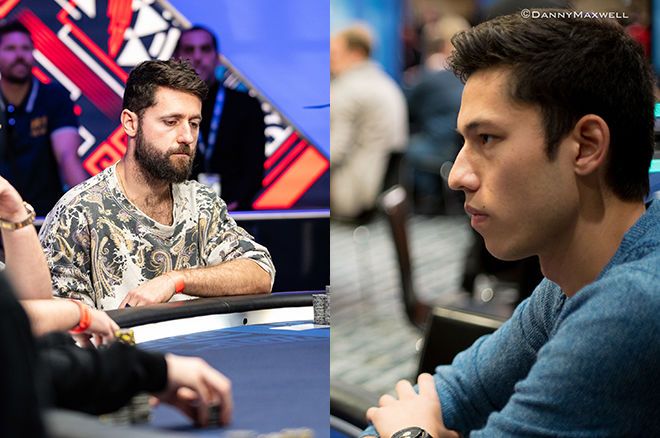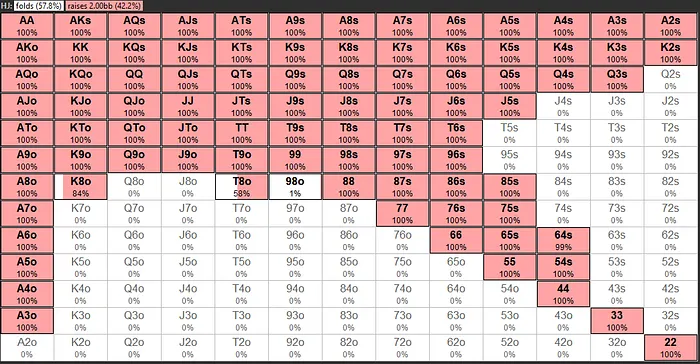Warning: Undefined array key "post_type_share_twitter_account" in /var/www/vhosts/casinonewsblogger.com/public_html/wp-content/themes/cryptocurrency/vslmd/share/share.php on line 24

It is only natural that hands that generate large pots garner the attention of the poker community. However, a hand at the final table of the 2024 $10,300 PokerStars World Championship Of Online Poker (WCOOP) Main Event shows that pots do not have to be huge for them to be interesting.
PokerNews ambassador Lukas “RobinPoker” Robinson uses GTO Wizard to delve deep into a hand involving Guillaume “Nolet20” Nolet and Darrell “FourSixFour” Goh, where both made strong hands by the river, yet the final pot was only 21 big blinds. Continue reading to discover if Nolet and Goh’s play was GTO Wizard-approved, and to see how small differences in bet sizes can have a dramatic effect on a player’s expected value (EV).
First, let’s set the scene with the remaining payouts, stack sizes, and positions of the seven remaining finalists.
Remaining Payouts
| Rank | Prize |
|---|---|
| 1 | $1,007,059 |
| 2 | $659,900 |
| 3rd | $487,407 |
| 4th | $351,448 |
| 5th | $252,488 |
| 6th | $182,960 |
| 7th | $136,521 |
Stack Sizes and Positions
| Player | Table Position | Stack (Big Blinds) |
|---|---|---|
| Davi “DaviMMaker” Cola | UTG | 40bb |
| Natrium111 | LJ | 12.6bb |
| Guillaume “Nolet20” Nolet | HJ | 146.1bb |
| Joao “IneedMassari” Simao | CO | 7.27bb |
| Pascal “Pass_72” Lefrancois | BTN | 60.7bb |
| Samuel “€urop€an” Vousden | SB | 32.7bb |
| Darrell “FourSixFour” Goh | BB | 118.1bb |
Here’s how the hand went down at the final table.
Pre-flop Action
Nolet20 opened to 2bb from the hijack (HJ) holding K♦10♣. FourSixFour defended from the big blind (BB) with A♥Q♣.
Post-Flop
Flop (5.38bb Pot): K♣10♠6♣
Action: FourSixFour checked. Nolet20 bet 1.4bb. FourSixFour called.
Turn (8.18bb Pot): J♦
Action: FourSixFour checked. Nolet20 bet 6.4bb. FourSixFour called.
River (21bb Pot): 4♣
Action: Both players checked.
An interesting hand between the table’s two biggest stacks. Both hit big hands postflop — a straight vs two-pair — but only a 21bb pot was played between them. Should they have played the hand differently? Let’s analyse it using the GTO Wizard solver.
Pre-flop Analysis
Nolet20 opened to 2bb from the HJ holding K♦10♣. GTO Approved ✔️

With the chip lead, the solver suggests opening 42% of hands from the HJ. As the big stack, you can apply maximum pressure by opening and shoving wider, since opponents are forced to overfold due to their bubble factor.
What is the Bubble Factor?
On a final table, the bubble factor is a way of quantifying the extra risk you face when you’re at risk of elimination compared to when you’re the one putting pressure on opponents.
FourSixFour defended from the BB with A♥Q♣. GTO Approved ✔️

Why is There No Three-Betting Here?
As the second-biggest stack, you have the most to lose against the chip leader. The priority becomes survival, not bloating pots with the one player who can cripple you. That’s why the solver shows only flatting: the bubble factor makes the risk-adjusted EV of three-betting far too low.

What a 2.75 bubble factor means:
- The risk of busting is 2.75x more costly than the reward of doubling up.
- In other words, losing hurts nearly three times as much as winning helps in ICM terms.
- A 2.75 bubble factor is extremely punishing, and you only continue with very strong hands, and chip leaders can pressure you relentlessly.
Post-flop Analysis
Flop (5.38bb Pot): K♣10♠6♣
FourSixFour checked A♥Q♣ on the flop. GTO Approved ✔️

The solver recommends zero donk-betting from the BB on this flop.
Nolet20 bet K♦10♠ 1.4bb on the flop. GTO Approved ✔️

The solver recommends continuation-betting range on this board, splitting between two bet sizes: 26% and 50%.
Recommended Bet Sizes and EV for KTo:

As shown above, every KTo combo is mixing between these two bet sizes.
FourSixFour called the 1.4bb bet on the flop with A♥Q♣. GTO Approved ✔️

Just like preflop, there is zero raising on the flop. This is again because players want to avoid building big pots against the chip leader, and simply calling allows them to continue safely.
Turn (8.18bb Pot): J♦
FourSixFour checks the turn with A♥Q♣. GTO Approved ✔️

Interestingly, the solver recommends some donk-betting on this specific turn from the BB. Let’s take a closer look at why.
EV and Equity Comparison between BB (Left) & HJ (Right):

The J♦ turn shifts EV and equity in favor of the BB’s range. Normally, this wouldn’t happen, as the BB typically three-bets the top of their range. However, since the BB has a mostly calling range on the flop and no capped hands, the turn now allows for donk-betting, taking advantage of the shift in equity and EV on this specific card.
Recommended Bet Sizes and EV for AQo:

AQo combos are recommended to mix between betting and checking, with EV nearly identical for both options. The 24% bet size serves two purposes: it keeps the pot manageable against the chip leader, while still allowing you to extract value from many hands in your range.
Nolet20 bet 6.4bb on the turn with K♦10♣. GTO Approved ✔️

Despite the shift in EV and equity on this turn card, the HJ still holds 18.8% of the best hands compared to the BB’s 17.6%, which allows the HJ to continue betting for value with these top hands, including KTo.
Recommended Bet Sizes and EV for KTo:

K♦10♣ mixes between all three bet sizes, so the 6.4bb (78%) bet used in this hand is fully solver-approved.
FourSixFour called the 6.4bb bet on the turn with A♥Q♣. GTO Approved ✔️

Now this is where it gets interesting. The solver recommends a high percentage of calling with the entire continuing range, likely to keep the pot small against the chip leader while employing a very polarized raising strategy. AQo mixes between raising and calling, so let’s take a closer look at the EV differences between each AQo combo.
Recommended Raise Sizes and EV for AQo:

Above, you can clearly see a distinction between the AQo combos that include a club and those that don’t. Combos without a club mostly opt to call, while those with a club tend to raise, even though the EV is slightly higher for calling in most cases. This likely comes down to blocking combo draws, particularly straight and flush draws containing the A♣ or Q♣, which are hands most likely to continue against a raise and carry significant equity against the nut straight.
By calling rather than raising, FourSixFour avoids bloating the pot and facing tricky river decisions out of position against the chip leader. This is a very well-played turn, as most players (including myself) would likely raise 100% of the time with this hand, holding the nuts.
River (21bb Pot): 4♣
FourSixFour checked the river with A♥Q♣. GTO Approved ✔️

With the flush now complete and no longer holding the nuts, checking with your range, including A♥Q♣, makes a lot of sense on the river.
Nolet20 checked the river with K♦10♣. GTO Disapproved ✖️

The solver suggests checking back with many strong hands on this river card, but K♦10♣ is not one of them.
Recommended Bet Sizes and EV for KTo:

The solver recommends betting K♦10♣ exclusively with the 67% sizing. While many KTo combos without a club check, holding the 10♣ is crucial, as it blocks a portion of the BB’s flush combos. This allows the HJ to value bet K♦10♣, extracting value from worse two pair hands and top pairs. These are very fine margins, and with this being the only real mistake on the hand, we can cut Nolet20 some slack for this check!
Conclusion
A super complex final table hand that highlights the dramatic effect ICM and bubble factors have on navigating pots versus a stack that covers you, even as the second-largest stack.
- Before analysing the hand, I wanted to answer three key questions:
- What hands does the BB want to 3-bet preflop? Answer: Zero
- Does A♥Q♣ really just want to call the turn? Answer: Sometimes.
- Does K♦10♣ want to value bet the river? Answer: Yes
This hand was played at an exceptionally high level from both players, and it shows why they deserved to be sitting first and second in chips at this $10K final table. The only real mistake came on the river, when Nolet20 checked K♦10♣ instead of value betting, but even that didn’t lose a significant amount of EV.
If reviewing this hand leaves you thinking you could improve your ICM game, use the link below to sign up for GTO Wizard and start analysing hands today.




